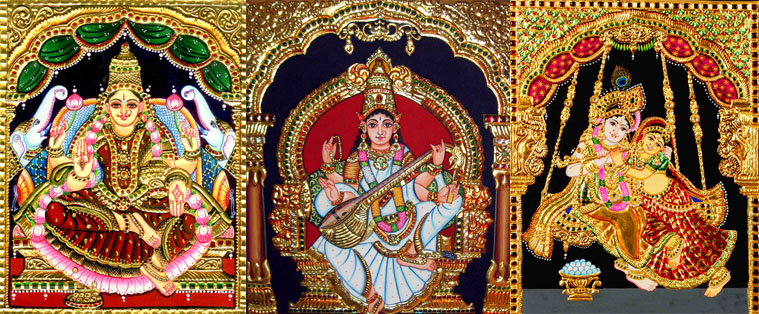Discover Thanjavur Paintings: Timeless Indian Art

Overview of Thanjavur Paintings
Thanjavur Paintings are a traditional style of art work with its origin in Thanjavur or Tanjore. This art form dates back to the Maratha court of Thanjavur (1676-1855). Thanjavur paintings have been recognized as a Geographical Indication by the Government of India in 2007-08.
Image Attribution : Richard Mortel
History of Thanjavur Paintings
Thanjavur paintings have evolved over the years. Here’s a look at the history of Thanjavur paintings.
- Thanjavur paintings date back to as early as the period of Cholas (11th century) and Nayaks (16th century).
- With the fall of Vijayanagar Empire, some of the painters migrated to Thanjavur and worked under the patronage of the Thanjavur Nayaks.
- Later, when the Thanjavur Nayaks got defeated by the Maratha rulers, there was an evident influence of the Maratha patrons on the artists. This led to the evolution of the unique style of Thanjavur paintings.
- Thanjavur artists were involved in painting and decorating temples, palaces and residences of the Maratha kings and aristocrats.
Style and Themes of Tanjore Paintings
The characteristics and themes of Tanjore paintings are extensive and unique. Here are a few insights into the style in which Thanjavur paintings were created-
· The subject for most of the paintings is tales from Hindu mythology.
· Hindu gods, goddesses, saints, puranic tales and religious texts form the central part of Thanjavur paintings surrounded by other themes and figures.
· The paintings are distinguished by vivid and bright colours, intricate iconic representations embellished by gold coating.
· Thanjavur paintings are usually done on a canvas pasted on wooden planks.
The Making of Tanjore Paintings
The base for the Tanjore painting is a wooden plank on which a cloth is pasted. A preliminary sketch of the drawing is made on the base. To the base, a mixture of chalk powder/zinc oxide with water soluble adhesive is applied. The drawing is then decorated with pearls, glass beads or even with precious stones. To enhance the effect of the painting, bright hues are used for some parts of the painting while the other parts are pasted with thin gold sheets.
Artists of Thanjavur Paintings
The artists behind paintings in Thanjavur style belonged to the Raju community of Thanjavur and Trichy and the Nayadu community of Madurai. These artists were from the Rayalseema region of Andhra who originally spoke Telugu. But with the fall of Vijayanagar rule and the forming of Nayak rule in Thanjavur and Madurai, they opted to move to Tamil Nadu. Many of the artists from yesteryears remained anonymous owing to the artistic tradition.
Display of Thanjavur Paintings
Fine examples of Thanjavur paintings are displayed for public at the below mentioned places:
- Saraswathi Mahal in Thanjavur
- The Government Museum, Chennai
- Thanjavur Art Gallery, Thanjavur
- The British Museum and the Victoria and Albert Museum, England
- The National Museum of Copenhagen, Denmark
Epilogue
Though the crafting methods and materials used have drastically changed over the years, this ancient art form continues to gain popularity. Thanjavur paintings are often used as souvenirs of art to decorate walls or as a perfect gift for art lovers.
Buy Thanjavur Paintings online:
If you want to buy the famous Thanjavur Paintings online, click to Thanjavur Paintings Online
